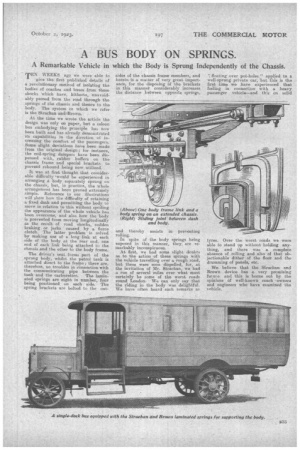A• BUS BODY ON SPRINGS.
Page 21

If you've noticed an error in this article please click here to report it so we can fix it.
A Remarkable Vehicle in which the Body is Sprung Independently of the Chassis.
TEN WEEKS ago we were able to give the first published details of a revolutionary method of isolating the bodies of coaches and buses from those shocks 'which have, hitherto, unavoidably passed from the road through the springs of the chassis and thence to the body. The system to which we refer is the Strachan andaBrown.
At the time we wrote the article the design was only on paper, but a saloon bus embodying the principle has now been built and has already demonstrated its capabilities in the direction of increasing the comfort of the passengers. Some slight deviations have been made from the original design; for instance, the coil-spring dampers have been dispensed with, rubber buffers on the chassis frame and special brackets to prevent rebound being now utilized.
It was at first thought that considerable difficulty *would be experienced in arranging a body separately sprung on the chassis, bet, in practice, the whole arrangement has been proved extremely simple. Reference to our illustrations will show how the difficulty of retaining a, fixed dash and permitting the body to move in relation to this without spoiling the appearance of the whole vehicle has been overcome, and also how the 'body is prevented from moving longitudinally as the result of road shocks, sudden braking or jerks caused by a fierce clutch. The latter problem is solved by making use of a long link at each side of the body at the rear end, one end of each link being attached to the chassis and the other to the body frame.
The driver's seat forms part of the sprung body, whilst the petrol tank is attached direct to the frame; there are, therefore, no troubles in connection with the communicating pipe between the tank and the carburetter. The laminated springs are eight in number, four being positioned on each side. The spring brackets are bolted to the out
sides of the 'chassis frame members, and herein is a matter of very great importance, for the disposing of the brackets in this manner considerably increases the distance between opposite springs, and thereby assists in preventing rolling. In spite of the body springs being exposed in this manner, they are remarkably inconspicuous. At first, we had some slight doubts as to the action of these springs with the vehicle travelling over a rough road, but these were soon dispelled, for, at the invitation of Mr. Strachan, we had a run of several miles over what must certainly be some of the worst roads round London. We can only say that the riding in the body was delightful. We have often heard such remarks as floating over pot-holes" applied to a well-sprung private car, but this is the first time we have experienced that feeling in connection with a heavy passenger vehicle—and this on solid tyres. Over the worst roads we were able to stand up without holding anything, and there was a complete absence of rolling and also of that objectionable dither of the Root and the drumming of panels, etc.
• We believe that the Strachan and Brown device has a very promising futui e and this is borne out by the opinions of well-known coach 'owners and engineers who have examined the e hie I e
































